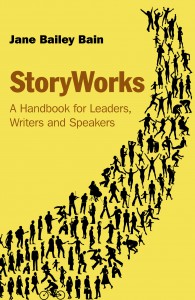
When two people get together, they start to tell stories. Friends meeting in a cafe. Colleagues back at work on Monday morning. Strangers sitting together on a long-distance bus. We meet and we say, Tell me your story.
“How are you?”
“How was your weekend?”
“How is your journey going?”
“Fine” simply doesn’t answer the question.
Humans are storytelling animals. Other creatures communicate in different ways – the honeybee’s waggle, the dog’s warning bark – but only human beings string words together to form meaningful narratives of events. We use stories to explain, to teach and to entertain. When you want people to remember something, a good story makes it memorable. If you have to give an unwelcome message, a clever story renders it more palatable. And when you just want to amuse an audience, there’s nothing better than a well-told tale.
Why do we tell stories? Because they are the most effective form of communication. Stories work in many different ways. On the surface, they provide a narrative sequence of events. When one thing leads to another, we assume that the first incident caused the second. This is reassuring: it gives us a sense of meaning and purpose in life. At a deeper level, they speak to us with parallels and similes. They communicate both overt messages and implied meanings. Most of all, stories harness the power of imagery to work their magic on our minds.
Imagery is an incredibly powerful tool both for persuasion and for personal development. Everything that has ever been made – from an omelette to a space rocket – began as a picture in someone’s mind. Images provide a representation that can be transformed into a real thing. They provide us with a focus for our thoughts and efforts. And they let us imagine how things could be different: a metaphor provides the basis for metamorphosis.
When you meet other people, you communicate with them by telling stories. You recall a series of events and you string them together into a causal narrative sequence. In other words, you turn your own experiences into a story. You also listen to other people’s narratives. Their anecdotes show you how they have dealt with similar situations. Stories help you to interpret things that have happened to you. They provide possible templates for future action. A good story touches both your mind and your heart. Hearing stories can shift your perceptions and shape your dreams.
Telling tales creates new possibilities in your mind.
StoryWorks - A Handbook for Leaders Writers and Speakers
Jane Bailey Bain
Inspirational leaders know the power of story.
Top coaches use words as a tool for personal transformation.
Great speakers and writers realize the importance of narrative.
Do you have a new idea? A good proposal? A great product? The best way to sell it is by telling a story. This book shows you how to do that effectively.
StoryWorks is a practical handbook on how to tell stories. It ranges from classic tools like the ‘Rule of Threes’ to the new mnemonic ‘Five Finger Technique’. There are stories and creative exercises to expand your narrative repertoire.
If you’re a leader who wants to communicate well, a professional keen to improve your speaking skills, a manager with a team to motivate or a writer looking for more ideas – you’ll find resources here to inspire, to inform and to entertain.
Whether you have one minute to impress at an interview or the keynote speech at a conference, this book will help you tell better stories.
- Paperback £11.99 || $19.95
- May 29, 2015. 978-1-78279-986-3.
- BUY | AMAZON US | AMAZON UK
- eBook £4.99 || $7.99
- May 29, 2015. 978-1-78279-987-0.
- BUY | AMAZON US | AMAZON UK
Categories:
0 comments on this article








